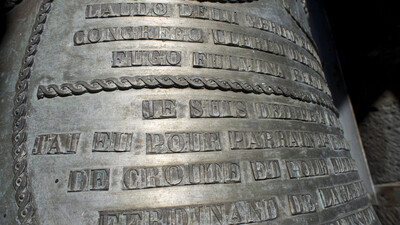
Rouen & Cantal
I came to France to enter into the sound world of post-enlightenment French countryside as depicted in Alain Corbin’s Le cloches de la terre – which in my opinion is one of the most important publications on 19th century European micro-history, and a case of historicizing through the auditory. Corbin’s book serves as a philosophical point of departure for the journey I am undertaking. Another work of literature that underpinned this part of the journey is Iris Murdoch’s The Bell, which I picked up in London, and turned the last page in Cantal. The Bell is about people’s struggles to define goodness, in a world in which our spiritual and moral beings – in the absence of God – depended on religious structures that the society as a whole had long-outgrown. The novel’s narrative unfolded through the consciousnesses of several characters. English poet A. S. Byatt once said that one of Murdock’s abiding lessons was “the difficulty and necessity of imagining other people, with centres of consciousness as real as our own, and different.” Yes, obviously, and more urgently so than ever before – but how does one actually go about attempting this? In Rouen I tried to explain to Pete and Stephen – who came to document the journey – the reason behind my choice of color for a certain sound in my sound drawings. I soon realized that this is an impossible conversation: how do I make you hear C major as a light, transparent yellow? (Pete’s C major is blue). What we could agree on is the idea of hearing in colors, and that there is a consistency to the structure of this peculiar experience that is specific to the individual. Here, effective communication seems improbable, but I have always thought that communication is over-rated. What we need is an awareness of other consciousnesses, and a sympathy for their many peculiar predicaments. And there are perhaps few better ways to get into another’s head than through a sound with a long decay. With me, listen to this: a bell is struck, a wave of metallic articulations slowly pierce through space. A ringing resonance lingers long after the abrupt percussive event, like the persistent afterimage of the camera flashlight. The surplus, the residuals of this sensory overload that burns our sonic-retina, sustains in us a portal to each other’s minds. An infinitely extended reverberation binds us in a consensual hallucination, which dissolves only when you allow your imagination to become disengaged.
And back to the topic of 19th century France: Corbin described a world in which the sound of these large sonorous objects defined territories, punctuated secular and religious times, marked life events, and called citizens to arms. They were also among the few arsenals at rural folks’ disposal against the inevitable forces of nature, such as plagues and storms. Corbin made frequent references to the department of Cantal in south-central France, where people believed in the magical power of bells to cast off thunderstorms. So deeply rooted was this belief that ringing in thunderstorm continued for well over a century after laws that prohibited the practice had already been put in place. Corbin also described the economy of bells in these small communities. Evidently, individuals were charged significant sums of money for ringing at important life events, such as wedding and funeral. In some villages, the richer inhabitants sponsored the casting of “public bells” that tolled for all without reward. In occasion such as this the whole community rallied. The rich and the poor came together to contribute what they could. Family jewels and cheap household metallic objects alike were thrown into the furnace. A public bell was the crystallization of a community’s collective aspiration.
On August 24th we left Rouen for Cantal, where the party was joined by art historian and manager Thomas Girst. I had wished to visit three bells: a public bell at l’Église Saint-Hilaire de Brezons, a “magic bell” (la cloche magique) that was believed to possess special power against thunders at Vigouroux, and a public bell at l’Église de Saint-Martin sous Vigouroux that bore the inscription “I shall ring for the rich as well as the poor.” After some initial uncertainties, and with the help of our local guide Beatrice, we managed to locate and recorded all three bells. We also visited the village of Labrousse, where in 1831 a fight broke out between villagers who held contrasting views regarding the tolling of the village’s bell, with one side believing that the bell’s sound encouraged thunderstorm, and the other side believing the exact opposite to be true. I had only read about this in an article in passing. There was mention of bloodshed in the church, but I did not harbor any hope that the villagers would have knowledge of this. Upon our arrival in Labrousse we encountered, as if by divine intervention, local historians Lucie and Claude Gard who actually wrote about the “bataille” in their book Monographie der Labrousse. Other remarkable individuals we encountered include local archeologist Annie Rassinot and her husband, who generously shared her knowledge of bells in Cantal and showered us with French hospitality; the many mayors who brought us into the beautiful churches and bell towers; and the innkeeper at Vigouroux who sang for us an Occitan folk song, about a bell that had fallen into the lake – which, incidentally, is also the premise of Murdock’s book.
In times of extreme and stormy weather, in churches along the coast and deep in the mountains, bells tolled for the lost traveller like sonic beacons of bright light. Scientist Charles Babbage once speculated that sounds never disappear entirely after an articulation, but are instead archived in the air, as imprints on the atmosphere’s particles, as “testimonies of man’s changeful will.”
To listen to the other recordings from this stop, go to http://soundcloud.com/samsonyoung/sets/for-whom-the-bell-tolls-rouen-cathedral-france & soundcloud.com/samsonyoung/sets/for-whom-the-bell-tolls-cantal


